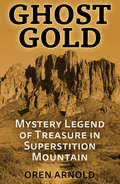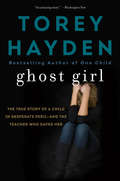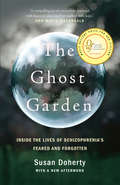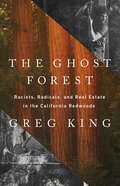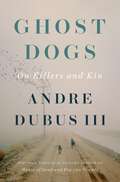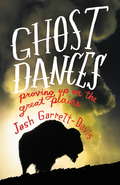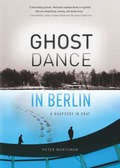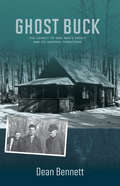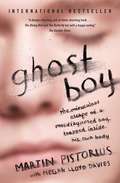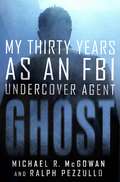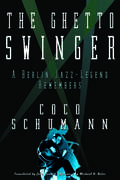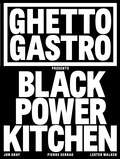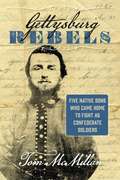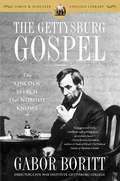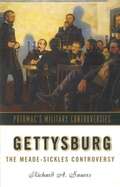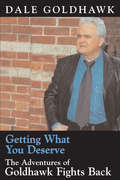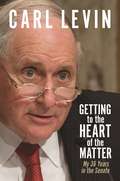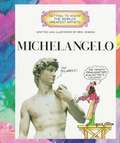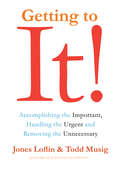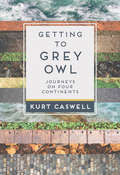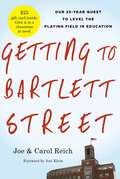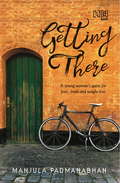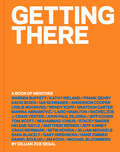- Table View
- List View
Ghost Gold: Strange Mystery Legend Of Treasure In Superstition Mountain
by Oren ArnoldGhost Gold, first published in 1954, is the story of Arizona’s Superstition Mountain and the Lost Dutchman Mine, a legendary mine containing a rich gold deposit (whether or not the mine does in fact exist remains an unanswered question). In a fascinating look at the mine’s history, author Oren Arnold (1900-1980) recounts the known facts and legends about the exploration and ‘discovery’ of the mine and the fate of some its the notable personalities (such as the “Lost Dutchman” himself—Jakob Walz). Included are 8 pages of illustrations.Author Oren Arnold was an authority on the lore of the West and wrote more than 20 books and many magazine articles.
Ghost Girl: The True Story Of A Child In Desperate Peril - And A Teacher Who Saved Her
by Torey HaydenJadie never spoke. She never laughed, or cried, or uttered any sound. Despite efforts to reach her, Jadie remained locked in her own troubled world . . . until one remarkable teacher persuaded her to break her self-imposed silence.Nothing in all of Torey Hayden’s experience could have prepared her for the shock of what Jadie told her—a story too horrendous for Torey’s professional colleagues to acknowledge. Yet a little girl was living in a nightmare, and Torey responded in the only way she knew how—with courage, compassion, and dedication—demonstrating once again the tremendous power of love and the resilience of the human spirit.
The Ghost Garden: Inside the lives of schizophrenia's feared and forgotten
by Susan DohertyA rare work of narrative non-fiction that illuminates a world most of us try not to see: the daily lives of the severely mentally ill, who are medicated, marginalized, locked away and shunned.Susan Doherty's groundbreaking book brings us a population of lost souls, ill-served by society, feared, shunted from locked wards to rooming houses to the streets to jail and back again. For the past ten years, some of the people who cycle in and out of the severely ill wards of the Douglas Institute in Montreal, have found a friend in Susan, who volunteers on the ward, and then follows her friends out into the world as they struggle to get through their days. With their full cooperation, she brings us their stories, which challenge the ways we think about people with mental illness on every page. The spine of the book is the life of Caroline Evans (not her real name), a woman in her early sixties whom Susan has known since she was a bright and sunny school girl. Caroline had formed a close friendship with Susan and shared stories from her life; through her, we experience what living with schizophrenia over time is really like. She has been through it all, including the way the justice system treats the severely mentally ill: at one point, she believed that she could save her roommate from the devil by pouring boiling water into her ear... Susan interleaves Caroline's story with vignettes about her other friends, human stories that reveal their hopes, their circumstances, their personalities, their humanity. She's found that if she can hang in through the first ten to fifteen minutes of every coffee date with someone in the grip of psychosis, then true communication results. Their "madness" is not otherworldly: instead it tells us something about how they're surviving their lives and what they've been through. The Ghost Garden is not only touching, but carries a cargo of compassion and empathy.
The Ghost Forest: Racists, Radicals, and Real Estate in the California Redwoods
by Greg KingThe definitive story of the California redwoods, their discovery and their exploitation, as told by an activist who fought to protect their existence against those determined to cut them down. Every year millions of tourists from around the world visit California&’s famous redwoods. Yet few who strain their necks to glimpse the tops of the world&’s tallest trees understand how unlikely it is that these last isolated groves of giant trees still stand at all. In this gripping historical memoir, journalist and famed redwood activist Greg King examines how investors and a growing U.S. economy drove the timber industry to cut down all but 4 percent of the original two-million-acre redwood ecosystem. King first examined redwood logging in the 1980s—as an award-winning reporter. What he found in the woods convinced him to leap the line of neutrality and become an activist dedicated to saving the very last ancient redwood groves remaining in private hands. The land grab began in 1849, when a &“green gold rush&” of migrants came to exploit the legendary redwoods that grew along the Russian River. Several generations later, in 1987, Greg King discovered and named Headwaters Forest—at 3,000 acres the largest ancient redwood habitat remaining outside of parks—and he led the movement to save this grove. After a decade of one of the longest, most dramatic, and violent environmental campaigns in US history, in 1999 the state and federal governments protected Headwaters Forest. The Ghost Forest explores a central question, an overhanging mystery: What was it like, this botanical Elysium that grew only along the Northern California coast, a forest so spectacular—but also uniquely valuable as a cornerstone of American economic growth—that in the end it would inspire life-and-death struggles? Few but loggers and surveyors ever saw such magnificent trees, ancient sentinels that, like ghosts, have informed King&’s understanding of the world. On a lifelong journey, King finds himself through the generations, and through the trees.A Next Big Idea Club Must-Read Title
Ghost Dogs: On Killers and Kin
by Andre Dubus IIIFrom the literary master and best-selling author of Townie, reflections on a life of challenges, contradictions, and fulfillments. During childhood summers in Louisiana, Andre Dubus III’s grandfather taught him that men’s work is hard. As an adult, whether tracking down a drug lord in Mexico as a bounty hunter or grappling with privilege while living with a rich girlfriend in New York City, Dubus worked—at being a better worker and a better human being. In Ghost Dogs, Dubus’s nonfiction prowess is on full display in his retelling of his own successes, failures, triumphs, and pain. In his longest essay, “If I Owned a Gun,” Dubus reflects on the empowerment and shame he felt in keeping a gun, and his decision, ultimately, to give it up. Elsewhere, he writes of a violent youth and of settled domesticity and fatherhood, about the omnipresent expectations and contradictions of masculinity, about the things writers remember and those they forget. Drawing upon kindred literary spirits from Rilke to Rumi to Tim O’Brien, Ghost Dogs renders moments of personal revelation with emotional generosity and stylistic grace, ultimately standing as essential witness and testimony to the art of the essay.
Ghost Dances: Proving Up on the Great Plains
by Josh Garrett-DavisA gifted young writer takes a singular journey back to his native Midwestern American Plains. Growing up in South Dakota, Josh Garrett-Davis always knew he would leave. But as a young adult, he kept going back-in dreams and reality and by way of books. With this beautifully written narrative about a seemingly empty but actually rich and complex place, he has reclaimed his childhood, his unusual family-and the Great Plains.Among the subjects and people who bring his Plains to life are the destruction and resurgence of the American bison; his great-great-grandparents' twenty-year sojourn in Nebraska as homesteaders; Native American "Ghost Dancers," who attempted to ward off destruction by supernatural means before the 1890 massacre at Wounded Knee; the political allegory to be found in The Wizard of Oz; and current attempts by ecologists to "rewild" the Plains. GHOST DANCES is a fluid combination of memoir and history and reportage that reminds us that our roots matter-and might even be inspiring and fascinating.
Ghost Dance in Berlin
by Peter WortsmanEvery great city is a restless work in progress, but nowhere is the urban impulse more in flux than in Berlin, that sprawling metropolis located on the fault line of history. A short-lived fever-dream of modernity in the Roaring Twenties, redubbed Germania and primped up into the megalomaniac fantasy of a Thousand-Year Reichstadt in the Thirties, reduced in 1945 to a divided rubble heap, subsequently revived in a schizoid state of post-World War II duality, and reunited in 1989 when the wall came tumbling down - Berlin has since been reborn yet again as the hipster hub of the 21st century. This book is a hopscotch tour in time and space.Part memoir, part travelogue, Ghost Dance in Berlin is an unlikely declaration of love, as much to a place as to a state of mind, by the American-born son of German-speaking Jewish refugees. Peter Wortsman imagines the parallel celebratory haunting of two sets of ghosts, those of the exiled erstwhile owners, a Jewish banker and his family, and those of the Führer's Minister of Finance and his entourage, who took over title, while in another villa across the lake another gaggle of ghosts is busy planning the Final Solution.
Ghost Buck: The Legacy Of One Man's Family And Its Hunting Traditions
by Dean BennettIn Ghost Buck, outdoorsman Dean Bennett takes readers along to the place where he feels most connected to nature and his family--Camp Sheepskin. Guided by his family's camp register, photos, and letters ranging from the 1800s to the present, Bennett reflects on his annual visits to his Western Maine camp since his boyhood. Through intimate narrative, he recalls hunting triumphs and defeats, including the elusive Ghost Buck that haunts the camp's surrounding forest. This multi-generational tale combines memoir, history, and politics as it illustrates the environmental and cultural changes that have altered hunting and the rural culture of the Maine woods. Ghost Buck is not a book about how to hunt, but rather a story of how a tradition like hunting in Maine can forge unshakeable family bonds
Ghost Boy
by Martin PistoriusIn January 1988, aged twelve, Martin Pistorius fell inexplicably sick. First he lost his voice and stopped eating; then he slept constantly and shunned human contact. Doctors were mystified. Within eighteen months he was mute and wheelchair-bound. Martin's parents were told that an unknown degenerative disease had left him with the mind of a baby and he probably had less than two years to live. Martin went on to be cared for at centres for severely disabled children, a shell of the bright, vivacious boy he had once been. What no-one knew is that while Martin's body remained unresponsive his mind slowly woke up, yet he could tell no-one; he was a prisoner inside a broken body. Then, in 1998, when Martin was twenty-three years old, an aromatherapy masseuse began treating him and sensed some part of him was alert. Experts were dismissive, but his parents persevered and soon realised their son was as intelligent as he'd always been. With no memory of the time before his illness, Martin was a man-child reborn in a world he didn't know. He was still in a wheelchair and unable to speak, but he was brilliantly adept at computer technology. Since then, and against all odds, he has fallen in love, married and set up a design business which he runs from his home in Essex.Ghost Boyis an incredible, deeply moving story of recovery and the power of love. Through Martin's story we can know what it is like to be here and yet not here - unable to communicate yet feeling and understanding everything. Martin's emergence from his darkness enables us to celebrate the human spirit and is a wake-up call to cherish our own lives.
Ghost: My Thirty Years as an FBI Undercover Agent
by Ralph Pezzullo Michael R. McGowanThe explosive memoir of an FBI field operative who has worked more undercover cases than anyone in history.Within FBI field operative circles, groups of people known as “Special” by their titles alone, Michael R. McGowan is an outlier. 10% of FBI Special Agents are trained and certified to work undercover. A quarter of those agents have worked more than one undercover assignment in their careers. And of those, less than 10% of them have been involved in more than five undercover cases. Over the course of his career, McGowan has worked more than 50 undercover cases. In this extraordinary and unprecedented book, McGowan will take readers through some of his biggest cases, from international drug busts, to the Russian and Italian mobs, to biker gangs and contract killers, to corrupt unions and SWAT work. Ghost is an unparalleled view into how the FBI, through the courage of its undercover Special Agents, nails the bad guys. McGowan infiltrates groups at home and abroad, assembles teams to create the myths he lives, concocts fake businesses, coordinates the busts, and helps carry out the arrests. Along the way, we meet his partners and colleagues at the FBI, who pull together for everything from bank jobs to the Boston Marathon bombing case, mafia dons, and, perhaps most significantly, El Chapo himself and his Sinaloa Cartel.Ghost is the ultimate insider's account of one of the most iconic institutions of American government, and a testament to the incredible work of the FBI.
The Ghetto Swinger: A Berlin Jazz-Legend Remembers
by John Howard Michael H. Kater Coco Schumann Michaela Haas Max Christian Graeff"From his early enthusiasm for American jazz in Berlin cabarets to his membership of Terezin's celebrated Ghetto Swngers and surviving Auschwitz through his music, to post-war appearances with the likes of Dizzy Gillespie, jazz remains a constant in a remarkable life story."- Ron Simpson, The Jazz RagSchumann's memoir offers an intimate look at the redemptive and sustaining power of music.
Ghetto Gastro Presents Black Power Kitchen
by Jon Gray Pierre Serrao Lester Walker Osayi EndolynNamed a Best Cookbook of 2022 by Barnes & Noble Named a Best Cookbook of Fall 2022 by Food & Wine, Forbes, Philadelphia Inquirer, Publishers Weekly, The Takeout, and moreAn American Library Association CODES Essential Cookbook of the YearShortlisted for The Art of Eating Prize&“This year&’s most important cookbook.&”—Vogue &“Every recipe comes with an immersive story, bringing you closer to the intent behind the dish.&”—The Strategist, The Year&’s Most Giftable Coffee-Table Books&“Featuring vibrant recipes, interviews, art, and photography, this is a compelling culinary manifesto about the nature of Black food. . . . Ghetto Gastro offers an awakening of what Black food was, is, and can become while demonstrating the sheer joy and creativity Black communities generate. With waves of crunch, heat, flavor, and umami, this Bronx culinary collective also inspires discussions about race, history, and long-standing food inequality.&”—Food & WineKnowledge Is Power Part cookbook. Part manifesto. Created with big Bronx energy, Black Power Kitchen combines 75 mostly plant-based, layered-with-flavor recipes with immersive storytelling, diverse voices, and striking images and photographs that celebrate Black food and Black culture, and inspire larger conversations about race, history, food inequality, and how eating well can be a pathway to personal freedom and self-empowerment.Ghetto Gastro Presents Black Power Kitchen is the first book from the Bronx-based culinary collective, and it does for the cookbook what Ghetto Gastro has been doing for the food world in general—disrupt, expand, reinvent, and stamp it with their unique point of view. Ghetto Gastro sits at the intersection of food, music, fashion, visual arts, and social activism. They&’ve partnered with Nike and Beats by Dre, designed cookware sold through Williams-Sonoma and Target, and won a Future of Gastronomy award from the World&’s 50 Best. Now they bring their multidisciplinary approach to a cookbook, with nourishing recipes that are layered with waves of crunch, heat, flavor, and umami. They are born of the authors&’ cultural heritage and travels—from riffs on family dishes like Strong Back Stew and memories of Uptown with Red Velvet Cake to neighborhood icons like Triboro Tres Leches and Chopped Stease (their take on the classic bodega chopped cheese) to recipes redolent of the African diaspora like Banana Leaf Fish and King Jaffe Jollof. All made with a sense of swag.
Gettysburg Rebels: Five Native Sons Who Came Home to Fight as Confederate Soldiers
by Tom McmillanGettysburg Rebels is the gripping true story of five young men who grew up in Gettysburg, moved south to Virginia in the 1850s, joined the Confederate army - and returned "home" as foreign invaders for the great battle in July 1863. Drawing on rarely-seen documents and family histories, as well as military service records and contemporary accounts, Tom McMillan delves into the backgrounds of Wesley Culp, Henry Wentz and the three Hoffman brothers in a riveting tale of Civil War drama and intrigue.
The Gettysburg Gospel: The Lincoln Speech That Nobody Knows
by Gabor BorittThe words Abraham Lincoln spoke at the dedication of the Soldiers' National Cemetery at Gettysburg comprise perhaps the most famous speech in history. It has been quoted by popes, presidents, prime ministers, and revolutionaries around the world. From "Four score and seven years ago. . . " to "government of the people, by the people, for the people," Lincoln's words echo in the American conscience. Many books have been written about the Gettysburg Address and yet, as Lincoln scholar Gabor Boritt shows, there is much that we don't know about the speech. In The Gettysburg Gospel he reconstructs what really happened in Gettysburg, Pennsylvania, on November 19, 1863. Boritt tears away a century of myths, lies, and legends to give us a clear understanding of the greatest American's greatest speech. In the aftermath of the bloodiest battle ever fought in North America, the little town of Gettysburg was engulfed in the worst man-made disaster in U. S. history: close to 21,000 wounded; very few doctors; heroic women coping in houses, barns, and churches turned into hospitals; dead horses and mules rotting in farmyards and fields; and at least 7,000 dead soldiers who had to be dug up, identified, and reburied. This was where Lincoln had to come to explain why the horror of war must continue. Planning America's first national cemetery revitalized the traumatized people of Gettysburg, but the dedication ceremonies overwhelmed the town. Lincoln was not certain until the last moment whether he could come. But he knew the significance of the occasion and wrote his remarks with care -- the first speech since his inauguration that he prepared before delivering it. A careful analysis of the Address and the public reaction to it form the center of this book. Boritt shows how Lincoln responded to the politics of the time and also clarifies which text he spoke from and how and when he wrote the various versions. Few people initially recognized the importance of the speech; it was frequently and, at times, hilariously misreported. But over the years the speech would grow into American scripture. It would acquire new and broader meanings. It would be better understood, but also misunderstood and misinterpreted to suit beliefs very different from Lincoln's. The Gettysburg Gospel is based on years of scholarship as well as a deep understanding of Lincoln and of Gettysburg itself. It draws on vital documents essential to appreciating Lincoln's great speech and its evolution into American gospel. This is an indispensable book for anyone interested in the Gettysburg Address, Abraham Lincoln, the Civil War, or American history.
The Gettysburg Gospel
by Gabor BorittThe words Abraham Lincoln spoke at the dedication of the Soldiers' National Cemetery at Gettysburg comprise perhaps the most famous speech in history. It has been quoted by popes, presidents, prime ministers, and revolutionaries around the world. From "Four score and seven years ago..." to "government of the people, by the people, for the people," Lincoln's words echo in the American conscience. Many books have been written about the Gettysburg Address and yet, as Lincoln scholar Gabor Boritt shows, there is much that we don't know about the speech. In The Gettysburg Gospel he reconstructs what really happened in Gettysburg, Pennsylvania, on November 19, 1863. Boritt tears away a century of myths, lies, and legends to give us a clear understanding of the greatest American's greatest speech. In the aftermath of the bloodiest battle ever fought in North America, the little town of Gettysburg was engulfed in the worst man-made disaster in U.S. history: close to 21,000 wounded; very few doctors; heroic women coping in houses, barns, and churches turned into hospitals; dead horses and mules rotting in farmyards and fields; and at least 7,000 dead soldiers who had to be dug up, identified, and reburied. This was where Lincoln had to come to explain why the horror of war must continue. Planning America's first national cemetery revitalized the traumatized people of Gettysburg, but the dedication ceremonies overwhelmed the town. Lincoln was not certain until the last moment whether he could come. But he knew the significance of the occasion and wrote his remarks with care -- the first speech since his inauguration that he prepared before delivering it. A careful analysis of the Address and the public reaction to it form the center of this book. Boritt shows how Lincoln responded to the politics of the time and also clarifies which text he spoke from and how and when he wrote the various versions. Few people initially recognized the importance of the speech; it was frequently and, at times, hilariously misreported. But over the years the speech would grow into American scripture. It would acquire new and broader meanings. It would be better understood, but also misunderstood and misinterpreted to suit beliefs very different from Lincoln's. The Gettysburg Gospel is based on years of scholarship as well as a deep understanding of Lincoln and of Gettysburg itself. It draws on vital documents essential to appreciating Lincoln's great speech and its evolution into American gospel. This is an indispensable book for anyone interested in the Gettysburg Address, Abraham Lincoln, the Civil War, or American history.
The Gettysburg Gospel
by Gabor BorittThe words Abraham Lincoln spoke at the dedication of the Soldiers' National Cemetery at Gettysburg comprise perhaps the most famous speech in history. It has been quoted by popes, presidents, prime ministers, and revolutionaries around the world. From "Four score and seven years ago..." to "government of the people, by the people, for the people," Lincoln's words echo in the American conscience. Many books have been written about the Gettysburg Address and yet, as Lincoln scholar Gabor Boritt shows, there is much that we don't know about the speech. In The Gettysburg Gospel he reconstructs what really happened in Gettysburg, Pennsylvania, on November 19, 1863. Boritt tears away a century of myths, lies, and legends to give us a clear understanding of the greatest American's greatest speech. In the aftermath of the bloodiest battle ever fought in North America, the little town of Gettysburg was engulfed in the worst man-made disaster in U.S. history: close to 21,000 wounded; very few doctors; heroic women coping in houses, barns, and churches turned into hospitals; dead horses and mules rotting in farmyards and fields; and at least 7,000 dead soldiers who had to be dug up, identified, and reburied. This was where Lincoln had to come to explain why the horror of war must continue. Planning America's first national cemetery revitalized the traumatized people of Gettysburg, but the dedication ceremonies overwhelmed the town. Lincoln was not certain until the last moment whether he could come. But he knew the significance of the occasion and wrote his remarks with care -- the first speech since his inauguration that he prepared before delivering it. A careful analysis of the Address and the public reaction to it form the center of this book. Boritt shows how Lincoln responded to the politics of the time and also clarifies which text he spoke from and how and when he wrote the various versions. Few people initially recognized the importance of the speech; it was frequently and, at times, hilariously misreported. But over the years the speech would grow into American scripture. It would acquire new and broader meanings. It would be better understood, but also misunderstood and misinterpreted to suit beliefs very different from Lincoln's. The Gettysburg Gospel is based on years of scholarship as well as a deep understanding of Lincoln and of Gettysburg itself. It draws on vital documents essential to appreciating Lincoln's great speech and its evolution into American gospel. This is an indispensable book for anyone interested in the Gettysburg Address, Abraham Lincoln, the Civil War, or American history.
Gettysburg: The Meade-Sickles Controversy
by Richard A. SauersThe book examines in depth the dissension among Federal generals that threatened the union's army ability to defeat the Confederacy.
Getting What You Deserve: The Adventures of Goldhawk Fights Back
by Dale GoldhawkFor 12 years Dale Goldhawk journeyed through the streets of Canada and into the hearts of thousands of Canadians. Written in Goldhawk’s punchy, to-the-point style, this book links his life as a journalist and advocate with those who were his clients. For the first time, he reveals the background battles and adventures he and his team had, as well as the stories of his clients and where they are today. The narrative paints a vivid picture of how working on Canada’s most original advocacy team changed their lives as journalists and Canadians.
Getting to the Heart of the Matter: My 36 Years in the Senate
by Senator Carl LevinRepresenting Michigan for thirty-six years in the U.S. Senate, Carl Levin, the longest-serving senator in Michigan history, was known for his dogged pursuit of the truth, his commitment to holding government accountable, and his basic decency. Getting to the Heart of the Matter: My 36 Years in the Senate is his story – from his early days in Detroit as the son of a respected lawyer to the capstone of his career as chair of both the Senate Armed Services Committee and the Senate Permanent Subcommittee on Investigations. Levin’s career placed him at the center of some of our nation’s most critical points in modern times: from the aftermath of the 1967 Detroit riots, to the Clinton impeachment, through 9/11 and the wars in Iraq and Afghanistan, and the 2008 financial crisis. He met with numerous world leaders, including Egypt’s Anwar Sadat and China’s Jiang Zemin. Getting to the Heart of the Matter recounts Levin’s experiences, thoughts, and actions during these historic moments. Consisting of seventeen chapters, the book takes the reader through Levin’s early life in Detroit of the 1940s, 50s, and 60s where he met his wife, started a family, practiced law and served as the first General Counsel for the newly created Michigan Civil Rights Commission and the chief appellate defender for Detroit’s Legal Aid Office. Elected to the Detroit City Council in 1969, where Levin served for eight years including four as Council president, the book describes how his fight against the Department of Housing and Urban Development’s devastating housing practices in the neighborhoods of Detroit led him to run for the U.S. Senate with a pledge to make government work more effectively. Winning election six times, Levin had an illustrious career in the Senate where he challenged leaders in government and the private sector for the greater good of the nation. Levin describes how, as a Democrat, throughout his time in the Senate, he worked with Republican senators who often held different policy positions in order to find common ground to achieve national goals, and how he and his Senate staff searched for creative solutions to trade issues, support for the auto industry and manufacturing sector, U.S. military action in Iraq and Afghanistan, and efforts to protect the Great Lakes and the environment, among many other issues. Levin’s hope in writing this memoir is that by sharing his deeply held beliefs about the responsibility of elected officials, the book will serve as a resource for people beginning a career in, or contemplating running for, public office. Readers with an interest in politics, history, facts, and perseverance will find kinship in this book.
Getting To Know The World's Greatest Artists: Michelangelo
by Mike VeneziaPresents a biography of Michelangelo
Getting to It
by Jones LoflinFrom Jones Loflin and Todd Musig, the authors of Juggling Elephants, comes Getting to It--a practical guide to sorting through the many priorities in your life, showing you how to carefully and consistently evaluate what your IT (Important Thing) should be, and how to get IT done. How busy are you? In the daily struggle to get it all done, what are you forgetting? Is your mind constantly racing with lists of all the things you could and should be doing? Does your day often feel like you're treading water in an ocean of rushes and deadlines, trying to keep from drowning while handling increasing work and life demands?Don't give up--help is on the way. You just have to find your It. The Important Thing. Define It. Plan It. Focus on It. Get excited about It. Identifying It isn't just the first step in the process of getting focused and heading in the right direction, it's every step. Getting to It Accomplishing the Important, Handling the Urgent, and Removing the Unnecessary provides the necessary tools to accomplish the important, handle the urgent, and get rid of the unnecessary. Want to enjoy a more fulfilling life? Get to It.
Getting to Grey Owl
by Kurt CaswellWriter, teacher, and adventurer Kurt Caswell has spent his adult life canoeing, hiking, and pedaling his way toward a deeper understanding of our vast and varied world. Getting to Grey Owl: A Man's Journey across Four Continents chronicles over twenty years of Caswell's travels as he buys a rug in Morocco, rides a riverboat in China, attends a bullfight in Spain, climbs four mountains in the United Kingdom, and backpacks a challenging route through Iceland's wild Hornstrandir Peninsula. Writing in the tradition of such visionary nomads as Hermann Hesse, Robert Louis Stevenson, Bruce Chatwin, Paul Theroux, Pico Iyer, Samuel Taylor Coleridge, and William Wordsworth, Caswell travels through wild and urban landscapes, as well as philosophical and ideological vistas, championing the pleasures of a wandering life. Far from the trappings of the everyday, he explores a range of ideas: the meaning of roads and pathways, the story of Cain and Abel, nomadic life and the evolution of the human animal, the role of agriculture in the making of the modern world, and the fragility of love.
Getting to Bartlett Street
by Joel Klein Carol Reich Joe ReichGetting to Bartlett Street is the inspiring story of Joe and Carol Reich--heroes in the education reform movement--how they built a school, changed the lives of many children, and helped redefine the system in the process. Joe and Carol Reich have spent the past three decades and a personal fortune to help underprivileged children access the same kind of high quality education that wealthier Americans enjoy. Yet few people even know who they are. In Getting to Bartlett Street, for the first time, Joe and Carol Reich tell the true story of how they started one of the first charter schools in the country in Williamsburg, Brooklyn. Since the Reiches began their work, the charter movement has spread across the country like wildfire, offering children a way out of failing schools managed by byzantine bureaucracies through privately managed public schools accessible to all through a simple lottery. But when they first conceived of their school, Beginning With Children, no one had ever started an independent public school anywhere in the country. Getting to Bartlett Street is a tale that will astound and inspire supporters of education reform everywhere. Joe Reich and Carol Reich are the co-founders of the Beginning with Children Foundation which opened the first charter-like school in New York City in 1992. Joe Reich also founded Reich & Tang, a leading investment firm in 1970. Carol Reich is the former president of the Lexington Center (formerly the Lexington School for the Deaf).
Getting there
by Manjula PadmanabhanLate 1970s, Bombay. Manjula is in her twenties, struggling to earn a living as an author-illustrator. Then, a deceptively routine visit to a diet clinic and an encounter with two tall Dutch men turn her life inside out. Without much ado she speeds off on a Westward-bound spiritual quest, which involves cheating on her boyfriend, lying to everyone she loves and cutting off all ties with her safe, respectable, bourgeois Indian upbringing. In this picaresque travel memoir, novelist, cartoonist and award-winning playwright Manjula Padmanabhan looks back on her youthful misadventures in Europe. By turns funny and fierce, Getting There will touch anyone who has ever wanted to strip off their skin to waltz, however briefly, on the wild side.
Getting There: A Book of Mentors
by Gillian Zoe Segal“The highest achievers share some of their lowest moments, and there is much wisdom to be gained from those struggles. Captivating, thought-provoking.” —David Faber, CNBCThe path to success is rarely easy or direct, and good mentors are hard to find. In Getting There, thirty leaders in diverse fields share their secrets to navigating the rocky road to the top. In an honest, direct, and engaging way, these role models describe the obstacles they faced, the setbacks they endured, and the vital lessons they learned. They dispense not only essential and practical career advice, but also priceless wisdom applicable to life in general. Getting There is for everyone—from students contemplating their futures to the vast majority of us facing challenges or seeking to reach our potential.“Kudos to Gillian Zoe Segal for assembling this remarkable group of visionaries and helping them all tell their stories without filters or false bravado. Getting There is both empowering and illuminating.” —Piper Kerman, New York Times-bestselling author of Orange Is the New Black“Life-changing, real-world advice.” —Vanity Fair“Reading Getting There is like having an intimate, one-on-one talk with some of the world’s most fascinating and accomplished people. You will be taken aback by their honesty, entertained by their anecdotes, and, most of all, learn invaluable lessons about both business and life. This book is fantastic—you will not be able to put it down!”—JJ Ramberg, bestselling author of It’s Your Business“Somehow, Gillian Zoe Segal has gotten these leaders to share their stories in a unique, authentic, and revealing way.” —Robert Steven Kaplan, former president and CEO of the Federal Reserve Bank of Dallas
